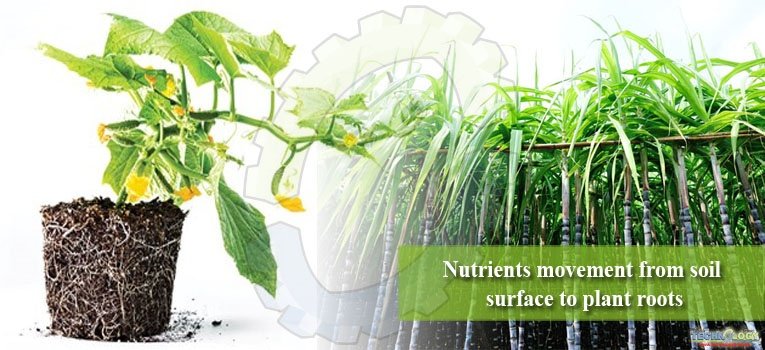There are about 16 essential nutrients which are required for plants, for their proper growth and development. Out of these 16, 13 are taken up by the plants through the roots.
 Firstly, nutrients reach to the roots and then, enter into the plant’s body where, they are used in different physiological, metabolic and morphological processes.
Firstly, nutrients reach to the roots and then, enter into the plant’s body where, they are used in different physiological, metabolic and morphological processes.
By keeping in view, the uptake of these 13 nutrients by the plants through the roots, movement of nutrient from the soil to the root surface is very crucial.
According to physiologists, there are three mechanisms which are involved in the movement of nutrients from soil to the root hairs of plants. These three processes are given as:
- Root interception
- Mass flow
- Diffusion
Root interception
In root interception, nutrients or ions move from soil surface to root surface by the physical contact between soil surface and mineral surface. Soil aggregates (different size and shape) are formed in the soil by reaction of different soil particles like sand, silt and clay with the soil organic matter.
The aggregates are rich in plant essential nutrients and nutrients exchange takes place by physically contacting the roots with the aggregates. Usually, growth of plant roots take place near the soil aggregates, therefore only small quantity (about 1-2%) of roots come physically in contact with these aggregates
Therefore, root interception is not a major mechanism in movement of nutrient from soil surface to root surface. Normally, on the root surface, Hydrogen ions (H+) are present. When, roots come in contact with another cation adsorbed by clay and organic matter, this H+ ion is exchanged by this cation.
Root interception is largely depend upon root’s volume or spreading of the roots. By increasing the root’s volume, movement of nutrients also increases and vice versa. Movement of some nutrients through root interception is given in table 1.
Mass flow
In mass flow, nutrients or ions move in a soil solution as a result of transpiration (loss of water from leaf surface) and percolation (movement of water from soil pores into the roots of plant).
Being negatively charged, nitrate (source of N), borate (source of B) and sulphate (source of S) are present in soil solution. Quantity of nutrients reaching the roots by mass flow depends upon
- Water consumption by the roots
- Concentration of nutrients present in soil solution
All the water is not utilized or used by the plants through roots; some quantity of water is lost by leaching below the root zone of plant. Due to this loss of water, the movement of nitrate, borate and sulphate quantity does not remain constant which largely depends on management practices.
So, as the water consumption by roots increases, nutrients movement through mass flow also increases. Nutrients movement through mass flow also increases by increasing their concentration in the soil solution and vice versa. Movement of some nutrients through mass flow is given in table 1.
Diffusion
The movement of nutrients or ions from an area of high concentration towards an area of low concentration is known as diffusion. It is the major mechanism involved in nutrients movement from soil surface to the roots.
Usually, positively charged ions (dissolved in soil water) like K+, Mg2+, Ca2+ move through diffusion. When, plants uptake nutrients from root zone, nutrients concentration decreases in the root zone.
Therefore, nutrients move towards the root zone (low nutrients concentration) from soil surface (high nutrients concentration) with the help of diffusion. Diffusion depends upon plant demand, rate of nutrients applied by fertilizer and placement of fertilizer.
Plant demand is most important factor affecting nutrient movement. As plant demand of nutrients increases, diffusion also increases. Diffusion is very slow, short distant (only few centimeters) but continuous.
Nitrogen, potassium and phosphorous moves through diffusion at distances of 1cm, 0.2cm and 0.02cm, respectively. Movement of some nutrients through diffusion is given in table 1.
Table 1: Percentage movement of some essential nutrients through root interception, mass flow and diffusion
Nutrients | Root interception (%) | Mass flow (%) | Diffusion (%) |
N | 1 | 99 | 0 |
P | 2 | 4 | 94 |
K | 2 | 20 | 78 |
Zn | 25 | 30 | 45 |
Fe | 8 | 40 | 52 |
S | 4 | 94 | 2 |
Ca | 12 | 88 | 0 |
Mg | 27 | 73 | 0 |
Authors: Tanveer Ahmad* and Rikza Anwar Ul Haq Awan
*Agro-Climatology Lab, Department of Agronomy, University of Agriculture, Faisalabad